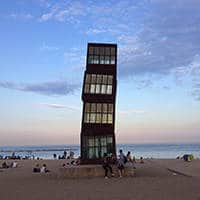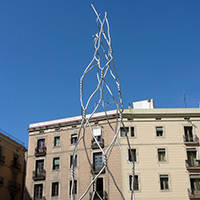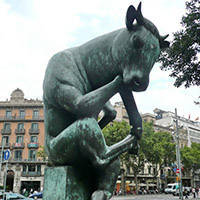Public art in Barcelona: works not to miss

Barcelona is one of the cities with the most public art in the world. But that hasn’t always been the case! Until the 19th Century, public space was limited due to the ramparts, and what there was was used for the market or festivities.
The ramparts were demolished but it was only at the end of Franco’s era that public space saw a renewal. Those newly elected to the city hall initiated a radical urbanistic change and took back the streets and squares. Art was one of the motivating forces behind this transformation, and sculptures were installed all over the city.
Today Barcelona is a real open air museum where you pass many sculptures from the end of the 20th Century by recognised artists.
Miró, Barcelona and public space
Joan Miró is forever associated with Barcelona: the Catalan artist is the pride of the region and attracts every day hundreds of visitors to his superb foundation.
 Barcelona airport fresco: Your feet barely touch the ground in Barcelona before you can admire its creative and artistic potential. The external wall of terminal 2 is covered with an immense fresco by Miró dating from 1968.
Barcelona airport fresco: Your feet barely touch the ground in Barcelona before you can admire its creative and artistic potential. The external wall of terminal 2 is covered with an immense fresco by Miró dating from 1968.
Where? Terminal 2B Barcelona-El Prat airport
 Pla de l’Os: You can also find Miró’s stamp on the mosaics on the ground of the Ramblas. Every day thousands of people from all over the world walk over it, sometimes without even realising. As the colours fade over time, the work was restored in 2006 on its thirtieth anniversary.
Pla de l’Os: You can also find Miró’s stamp on the mosaics on the ground of the Ramblas. Every day thousands of people from all over the world walk over it, sometimes without even realising. As the colours fade over time, the work was restored in 2006 on its thirtieth anniversary.
Where? La Rambla (between la Boquería and Liceu)
 Dona i Ocell: Miró also has a park in his name at the site of the old municipal abattoir. There you can find a colossal 22 metre-high sculpture called Dona i Ocell (woman and bird in Catalan), inaugurated in 1983 just before the artist’s death.
Dona i Ocell: Miró also has a park in his name at the site of the old municipal abattoir. There you can find a colossal 22 metre-high sculpture called Dona i Ocell (woman and bird in Catalan), inaugurated in 1983 just before the artist’s death.
Where? Parc Joan Miró (Eixample esquerra)
Public Art on the seafront
, Roy Lichtenstein: this sculpture was created by a celebrity of American pop art when Barcelona was preparing for the 1992 Olympic games.
It belongs to a series of portraits entitled Brushstrokes, referring to the way the colours are used to form the face. The sculpture is covered in mosaic as a homage to Catalan art nouveau.
Where? Passeig de Colom
(The prawn), Javier Mariscal:
This enormous prawn has a singular history as it was ordered in 1989 by a restaurant located on Moll de la Fusta. After the 1992 Olympic games, the restaurant almost closed but it now belongs to the city hall and is a symbol of the changes that occurred in Barcelona in the early 1990s.
Where? Passeig de Colom
(Injured star), Rebecca Horn: this ten-metre high sculpture is made of 4 iron cubes supposed to represent the xiringuitos (beach bar-restaurants) in poor condition but full of charm, and belonging to the pre-Olympic Barcelona.
Where? Sant Miquel beach
(Fish), Franck Gehry: at 56 metres long and 35 metres high, this steel fish is a true symbol of Barcelona’s Olympic port. Its curved shape and its material create beautiful golden and copper reflections of sunlight.
Where? Olympic Port (at the hotel Arts)
(Homage to swimming), Alfredo Lanz: as the name indicates, this sculpture represents bronze characters swimming in different styles: waterpolo, synchronised swimming, diving…the play between the material and space is particularly interesting.
Where? Plaza del Mar (Barceloneta)
(a room where it rains), Juan Muñoz: this installation is incomplete.
It is made up of two bronze characters in a sort of cage, but it does not include the sprinkler system envisaged by the artist, which would have given the full meaning to the work’s title.
Where? Plaza del Mar (Barceloneta)
Public Art in the old city
(The fat cat), Botero: this enormous cat by the sculptor Fernando Botero was bought by Barcelona city hall in 1987 and installed in the Parc de la Ciutadella, near the zoo.
It was then brought to the Olympic stadium before returning to the city behind the maritime museum. Since 2003 it seems to have found a suitable home: the Rambla del Raval. A horse in the same style is installed in Terminal2 of the airport.
Where? Rambla del Raval
(the wave), Jorge Oteiza: the MACBA plaza is home to this Richard Meier sculpture which looks like it is part of the building. It was made after the building was constructed to echo the architect’s work and it is made so that the shapes combine light and shadow, not just on the sculpture but also on the building.
Where? Plaça dels Angels (Raval)
(Sgrafitti), Pablo Picasso: not many people know that the facade of the Catalan college of architects (opposite the cathedral) is decorated with ornamental engravings made by Picasso himself.
Where? Plaça Nueva (Gòtic)
, Eduardo Chillida: this simple sculpture located in the heart of medieval Barcelona links old and modern Barcelona. It is remarkably well inserted and includes a number of arches reminiscent of medieval art, forming the B in Barcelona.
Where? Plaça del Rei (Gothic)
, Joan Brossa: just beside Topos V is Joan Brossa’s visual poem. Barcino is the Roman name for Barcelona, and the artist pays homage to the city’s ancient history with this work. Each letter is a work of art in itself.
Where? Plaça Nueva (Gothic)
(homage to castellers), Antoni Llena i Font: this curious sculpture is reminiscent of the castellers, the impressive human towers that are traditional in Catalonia. It is located just by the Plaça Sant Jaume, where the castellers can often be seen.
Where? Plaça de Sant Miquel (Gothic)
Public Art in the rest of the city
(David and Goliath), Antoni Llena i Font: this work is often described as an anti-monument. Erected in a formerly demolished area of the city it evokes sheets drying on balconies.
Paying homage to the buildings that made way for new constructions it depicts a popular win over the powers of urban development (hence the name).
Where? Plaça dels Voluntaris Olímpics (Vila Olímpica)
(Meditation (bull)), Josep Granyer: this animal version of Rodin’s Thinker has a sister at the crossroads of Rambla Catalunya and Diagonal avenue, a giraffe named Coquette.
These sculptures are part of a more global initiative by the artist that consists of animals in human postures, making up a “surrealist zoo”.
Where? Crossroads of la Rambla Catalunya and la Gran Vía (Eixample)
All of these works are just a few examples of the immense artistic wealth contained in Barcelona’s streets and squares. Enjoy hunting them out on your walks!
Also don’t forget to read our article on Street Art and our walk in the footsteps of Catalan Art Nouveau. There is art in the corner of every street in Barcelona!














